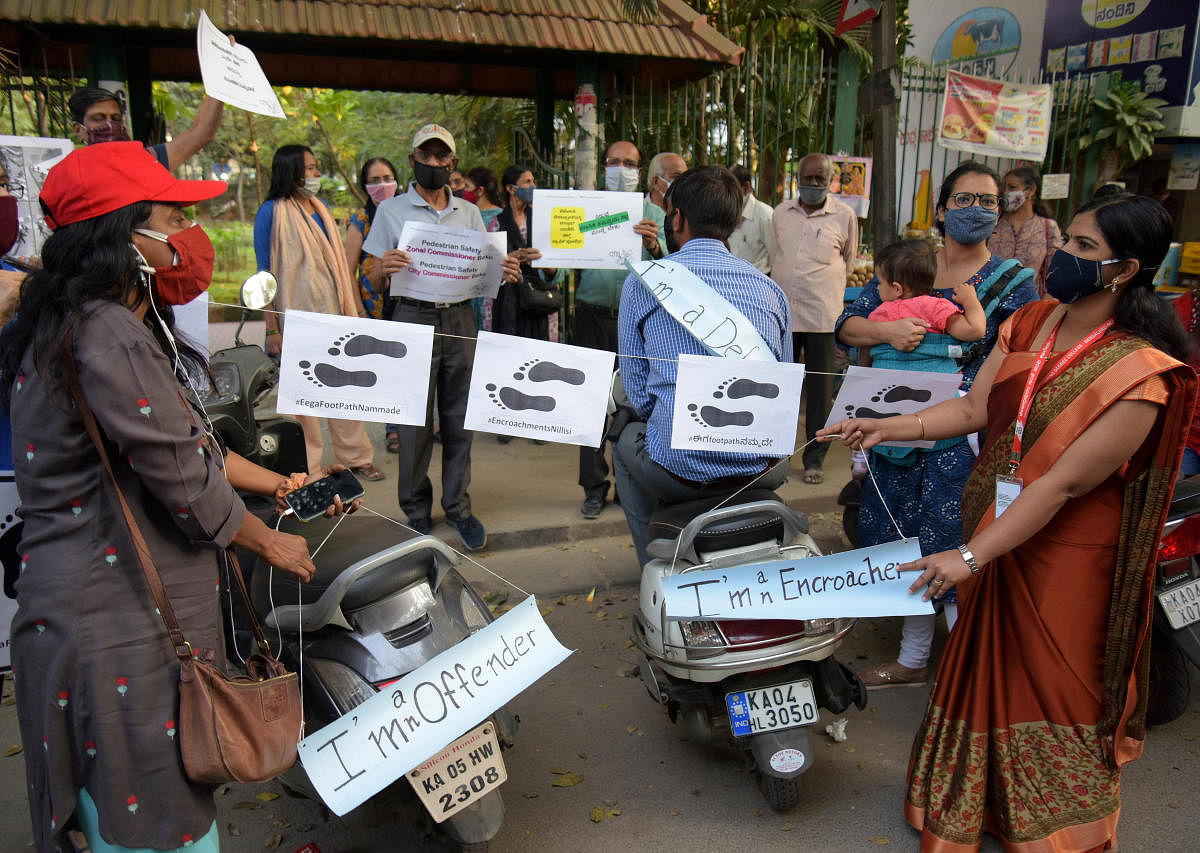
Varyingly called deathtraps and yellow spots, the Bengaluru;s footpaths have been the forgotten aspect of the road infrastructure that has claimed 270 lives over two consecutive years.
When potholes in the middle of the road grab all the attention, especially after the High Court’s admonishments of the Bruhat Bengaluru Mahanagara Palike over the last three years, footpaths, unsurprisingly, do not feature in the civic officials’ priority list.
The BBMP also seem to believe that not all roads need space for pedestrian infrastructure.
Bengaluru’s total road network, including the major, arterial, sub-arterial and ward roads, is estimated to be more than 13,000 kilometres. But only half of them have footpaths of varied qualities.
The National Crime Records Bureau (NCRB) data puts Bengaluru on top of the list of 89 cities reporting 272 pedestrian deaths in 2019, whereas, in the previous year, the city stood second with 276 fatalities.
A senior official claimed that footpaths are compulsory for only 2,000 kilometres of arterial, sub-arterial and high-density corridor roads, while collector streets or ward roads do not require them.
Activists, on the other hand, have been pointing out that main roads in residential areas have already turned into sub-arterial roads over the years due to swelling vehicle density. They accuse officials of losing touch with the ground reality.
“Though the BBMP and the state government announce on spending crores of rupees on footpaths, new encroachments, digging, dumping of debris, etc, caused by government agencies, endanger the life and limb of Bengalureans,” according to Citizens for Bengaluru, which conducted a campaign on Saturday.
Dancing on footpaths
For most residents of city neighbourhoods, a standard footpath with eight-feet width is a luxury.
A few roads are getting nearly 3.5-metre-wide footpaths under the Smart City Project, with 1.2- to 1.5-metre space marked as a cycle lane. “The width of the footpath depends on the width of the road,” an official said.
Pedestrians navigating on such slim pavements must often make way for bikes, negotiate parked cars, with uprooted, broken or uneven slabs and dangling electric wires only adding to their woes. The issue was best illustrated by activists from Malleshwaram Social in a viral video that showed how walking on Bengaluru’s footpaths was as complicated as performing Bharatanatyam.
Public urination zones
In the recently held ‘My City My Budget’ campaign by Janaagraha and BBMP, 4,781 complaints and suggestions were about improving footpaths. Citizens who contributed to the campaign pointed out that the pavements have become public urination zones.
The campaign succeeded in putting the focus on the dreadfully inadequate footpath infrastructure marked by yellow spots said Sapna Karim of Janaagraha.
Anjali Saini of Whitefield Rising said construction debris occupy the footpaths on many roads, except for those on the Whitefield main road and Varthur main road.
“At the newly made Graphite India Junction, they built the road but have left huge stones on either side of the footpath. Similarly, I reported a gap in the footpath right in front of the entrance gate to the Sheelavanthakere Lake where hundreds of people, including children, seniors and so many walkers, enter daily. But nobody has responded or taken action,” she said.
She said a system must be in place to maintain footpaths.
“To begin with, a weekly review should be conducted. But the BBMP keeps waiting for the High Court to order the removal of encroachments, cables, debris... or someone has to file a PIL.”
In 2015, Janaagraha held ‘I Change My City’, a street quality survey that identified 23,343 locations across the city where footpaths need to be laid, repaired or the debris needs to be cleared.
Janaagraha’s quality check of 3,318 km of roads showed that only 1,928 km had walkable footpaths.
But the walkability was only about 45% in outskirts, compared to 75% in the inner-city areas. It showed the BBMP has failed to recognise the need for pedestrian infrastructure in the newly developing areas.
The BBMP official noted that footpath and drain maintenance have been included and prioritised under the Annual Road Maintenance Contract (AMC) starting from this year.